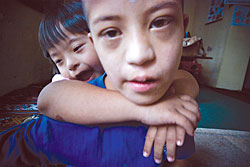|
|
Dipesh has slanted eyes, a low set nose, and ears with a slightly unusual shape. Born with Down's syndrome, his features set him apart from other children. Despite being mentally disabled, he was enrolled in a mainstream nursery school at the age of three.
Down's syndrome is a genetic disability caused by a chromosome shift. It is associated with a range of medical conditions, including mental impairment. Despite this, studies have shown that early intervention can allow people with Down's syndrome syndrome to lead a reasonably independent life.
Unfortunately, in Nepal there is no institution that individualises education and training for these children. Parents are therefore forced to choose between the two equally unsuitable alternatives of mainstream and 'special' schools, neither of which providess syndrome children with the kind of education they need.
Dipesh faced difficulties in a mainstream school, as the classes moved too fast for him. Special schools were just as difficult, as they inhibited his individual capabilities, causing him to retreat into himself. By the time he was 11, he had been enrolled at five different institutions.
Most parents of Down's syndrome children would rather send their children to a mainstream school, but some schools are reluctant to accept children with the condition. Many people think it is a contagious disease, says Shila Thapa, president of the Down's Syndrome Association. Even if they do get accepted, an extra amount of time and patience is required to integrate them into the school environment.
Pritam has been studying at the Abhiyan Boarding school for a year. Initially, the other children's parents told them not to mix with him. His hyperactivity and outpourings of affection, which are characteristic of many Down's syndrome children, are baffling and even intimidating to many.
His mother Dhana Kumari Sunar hoped that he would be socialised out of it and become more 'normal'. He has to learn normal behaviour to assimilate into society, she says. Fortunately, he is picking up the norms of his classmates and is gradually learning to behave like the rest. Other parents are slowly changing their perceptions and beginning to accept him.
But not all Down's syndrome children respond well to a mainstream learning environment. Seven-year-old Samridi went to pre-school when she was three. However, she fell behind in her class and couldn't do most of her homework, and in her three years at the school, she made no friends because she was unable to express herself. Samridi eventually fell into depression and had to drop out of school.
Imran Ansari, a pediatrician at Patan Hospital, says that the environment in mainstream schools can highlight the abnormality of Down's syndrome children and cause them to feel inferior. But Shila Thapa thinks this can be mitigated by keeping a close eye on the child's receptivity to the new environment. She says that getting them to socialise with other children is almost as important as giving them an education. The DSA currently sends children for short lessons at mainstream schools and only makes them continue to attend if they respond well.
But she says that this is only a stopgap measure necessitated by the current lack of provision available in Nepal. Down's syndrome children ultimately do need a different education, and in developed countries, she says, there are calibrated curriculums in designated schools to help Down's syndrome children advance their interest or talents into a career.
Dipesh, now 18, just dropped out from a special school which he had been attending for seven years. Unequipped with skills, he cannot take up a job to support himself. In Nepal, many people with Down's syndrome who have reached or passed working age are stuck either in schools or at home.
A late intervention is better than none at all. Dipesh and others like him are still waiting for assistance to help them live independently.
What is Down's syndrome?
A genetic condition caused by the presence of an extra chromosome 21. A baby born with Down's syndrome has three copies of chromosome 21 instead of the usual two.
Cause
Unknown, although mothers above the age of 35 stand a higher risk.
Characteristics
Mental disability, differing from child to child, it ranges from mild to severe. It is associated with a range of developmental difficulties, which include delayed motor skills (such as sitting, crawling and walking in infancy) and delayed cognitive skills (such as speech and language acquisition and short-term memory abilities).
Incidence
One in every 800 live births worldwide.



